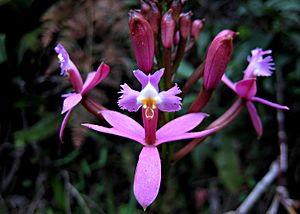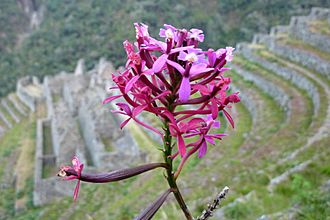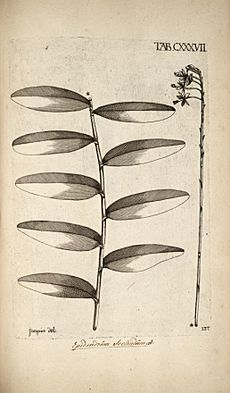Epidendrum secundum facts for kids
Quick facts for kids Epidendrum secundum |
|
|---|---|
 |
|
| Scientific classification | |
| Genus: |
Epidendrum
|
| Species: |
secundum
|
Epidendrum secundum is a beautiful type of orchid often called a "crucifix orchid." It's a bit of a mystery to scientists because there are many different kinds that look similar. Some experts even think these different kinds might be their own unique species!
One cool fact about E. secundum is that it has the longest seeds of any orchid. Its seeds can be 6.0 mm long, which is quite big for an orchid seed! For comparison, another crucifix orchid, E. ibaguense, has seeds that are only 2.9 mm long.
Like other orchids in its group, E. secundum grows in a special way. It has thin stems covered with layers of leaf-like coverings. The leaves grow higher up on the stem. Its flowers grow in a cluster at the very top of the stem. The flowers come in many colors like purple, red, orange, or yellow. They have a unique lip that is attached to the main part of the flower. Unlike some other orchids, its flowers don't turn upside down. This plant likes cooler weather and can even handle a little bit of frost.
Contents
Many Kinds of Epidendrum secundum

Scientists have studied Epidendrum secundum for a long time. Back in 1861, a scientist named H. R. Reichenbach looked at many different orchids in this group. He thought many of them were separate species. However, today, many of those plants are considered to be just different forms of E. secundum. This shows how much variety there is within this one "species complex."
For example, some plants that were once called E. ansiferum or E. fimbria are now seen as part of the E. secundum family. This happens a lot in science as we learn more about plants and animals.
The variety in E. secundum is also seen in its chromosomes. Chromosomes are tiny parts inside cells that carry genetic information. Different E. secundum plants from different places have different numbers of chromosomes. For instance, a purple-flowered plant from Bolivia might have 28 chromosomes, while a purple-flowered plant from Venezuela might have 80! This wide range in chromosome numbers shows how diverse this orchid group truly is.
What's in a Name?

The name Epidendrum secundum was given by a scientist named Jacquin in the 1700s. The word "secundum" means "one-sided" or "arranged on one side." However, this orchid's flowers don't actually grow on just one side of the stem. Instead, they grow all around the stem in a cluster. So, the name can be a bit confusing!
Even though the name "Epidendrum" means "upon a tree," E. secundum doesn't always grow on trees. It often grows on the ground, especially in rocky areas. Because of these reasons, some of the "common names" that are just direct translations of the scientific name (like "lop sided star orchid") aren't very helpful or accurate. It's better to use its scientific name or a local common name if one exists.
Where It Grows
Epidendrum secundum grows in the mountains of Central and South America, a region called the Neotropics. You can find it high up in the forests, sometimes as high as 2 miles above sea level! It has been found in places like Cusco in southeastern Peru and various parts of Brazil.
Interestingly, it can also grow in places where the land has been changed by humans, like along roadsides. For example, it has been seen near sea level in Picingauba, Brazil. In these areas, it sometimes grows alongside another orchid called Epidendrum fulgens, and sometimes they even create natural hybrid plants together!
Images for kids
See also
 In Spanish: Epidendrum secundum para niños
In Spanish: Epidendrum secundum para niños




